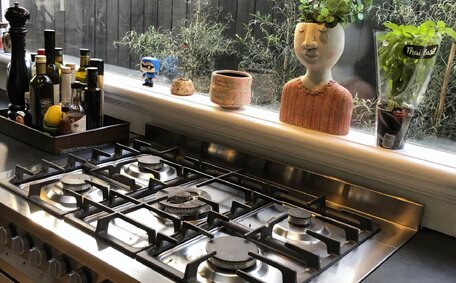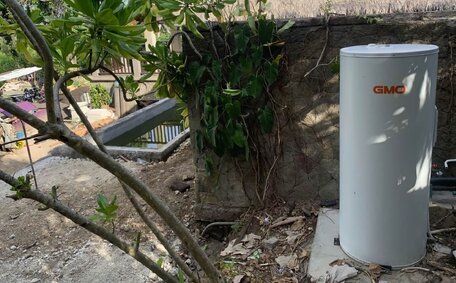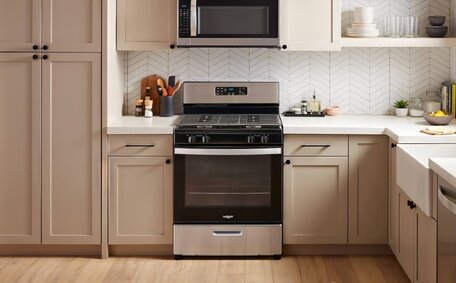
Financial Benefits of Natural Gas
Natural gas offers many financial perks over other energy sources. It burns cleaner and costs less than alternatives, helping lower monthly bills.
Read MoreAdjusting the settings on your hot water heaters for different seasons can help optimise performance, prevent hazards, and reduce energy costs. At Balmain Plumbing, we want to help you navigate the maze of settings to find the ideal match for your specific model and household needs.
During summer, lowering your hot water heater’s temperature can decrease unnecessary heating and save money. In winter, a higher temperature setting ensures comfortable and safe hot water delivery even on cold days.
Having the heater set at a temperature too high risks scalding and wastes energy, while water should not be too low as it increases the risk of bacteria like Legionella.
Striking the right balance with your storage tank heater temperature is key. We recommend a temperature hot water storage around 50-60 degrees Celsius to eliminate Legionella with minimal energy wastage. Tempering valves near taps provide extra protection against burns. Insulating pipes can also reduce heat losses ensuring the warmth circulates effectively throughout your house.
The need to adjust your water temperature in your hot water tank takes just a few minutes. Minor adjustments to adjust temperature your settings translate to major savings and comfort.
Integrating a storage tank heat pump tailored to the season and your household’s energy usage, you can elevate the efficiency and safety of your hot water temperature. Our upcoming sections investigate optimal temperatures, energy savings, safety, and when you need adjust settings in precise detail. Reach out if you need a hand with the best ways to heat water optimally for your system’s performance.
Maintaining recommended settings for your hot water systems is essential in curbing the proliferation of hazardous Legionella bacteria. Storage temperatures below 60°C allow Legionella to rapidly multiply to hazardous levels. At 50°C, the bacteria can double in count every few hours.
Legionella bacteria struggle to survive in environments heated beyond 120 degrees Fahrenheit, such as maintained hot water tanks. Such conditions are suitable for the growth of Legionella, including storage tanks, pipework deadlegs, infrequently used taps, and shower heads. Inhaling airborne water droplets containing the bacteria can cause Legionnaires’ disease, a severe form of pneumonia.
By setting your controls around 60 degrees Celsius, you control Legionella growth while minimising scalding risks and energy wastage. Higher-risk hot water heater set-ups with complex pipework or elderly occupants warrant extra precautions like periodic thermal disinfection.
Allow us the opportunity to ensure vigilant temperature monitoring and proper disinfection protocols where vulnerable people may get exposed. Don’t take chances with water safety – if you’re in doubt, give us a ring to inspect your hot water system.
The recommended ideal temperature for set hot water system’s storage spans between 50-60°C. This strikes an optimal balance between preventing Legionella bacteria growth, avoiding scalds, and maximising energy efficiency.
Avoid setting the temperature too low, as 50 degrees Celsius is the benchmark below which Legionella can rapidly multiply to dangerous levels. Every 5°C increase from 50-60°C halves the bacteria’s growth rate. At 60°C, Legionella struggles to grow at all.
Conversely, temperatures set too high consume more energy and become more expensive, while also increasing scald risks with negligible Legionella prevention benefits. Ensure hot water is no more than 50°C which can cause third-degree burns in just 5 seconds. Tempering valves by taps provide extra protection.
Insulating pipes on the same day as adjustment reduces cooling between the heater and outlets, enabling the storage of hot water at lower temperatures while still delivering warmth. Combine this with periodic thermal disinfection of higher-risk systems, and temperatures of 50-60°C provide effective, efficient protection in most homes.
Thermostatic mixing valves are an effective means of maintaining water flow and temperature to prevent accidental scalding. Installed close to outlets, these self-regulating devices automatically blend hot and cold water to deliver at a consistent, safer temperature up to 50°C.
For your family’s safety in the home, setting the system to water your household with regulated temperatures using thermostatic mixing valves can provide an extra layer of protection. Set to 50°C, they restrict temperatures to levels less likely to cause severe burns in the event of slips or falls in the bathroom.
Beyond safety, mixing valves also allow the hot water system itself to be set higher for optimal energy efficiency and Legionella control. Water stored at 60-65°C can be tempered down to a safe yet comfortable 45-50°C, often considered the best temperature at the point of use. This balance minimises risks while saving energy and water.
Installing thermostatic mixing valves, ensuring the right temperature for safe water use, is a straightforward process that requires precision for reliable operation. Our licenced technicians can fit new valves or service your existing heating system - contact us today to keep your household hot water safe.
Discover ways save on bills while still getting your water heated efficiently with the right hot water system’s settings - a simple action for optimised cost and efficiency. In summer, have your hot water heater set to your desired comfort, usually to a lowered 50-55°C since heating demands are reduced. By contrast, discovering ways to save, winter may require you to turn hot water temperatures around 58-65°C to supply sufficient warmth during colder periods.
This clever strategy curtails home energy consumption unnecessarily.
Insulating your pipes and bolstering your hot water system’s efficiency are savvy methods to save on gas electric bills. This reduces standby heat losses, which can help in lowering your electric bills while still meeting demand. For electric and gas hot systems, consider installing timers to switch your heating off overnight.
Gas systems lose less passive heat, but turning the thermostat down can reduce your bills at night and when away can still save energy.
Your solar water heating systems with solar panels require extra fine-tuning to maximise energy savings. Turn off electric heating elements during sunny periods and ensure the circulation pump activates for a few hours midday when panels peak. When comes balancing solar energy supply, it’s vital to carefully adjust and boost capacity across seasons.
For households with irregular or seasonal occupancy like holiday homes, consider partially or fully draining the water heater during extended vacancies. This step is crucial to make sure your showers remain comfortable without incurring standby losses. Just ensure to thoroughly flush and disinfect the tank upon re-commissioning.
As seasons change, Strategically use your system’s thermostat adjustments to optimise comfort and cost-savings in your hot water setup. We recommend lowering it to 50°C during warmer months since heating demands drop.
Conversely, set the temperature to 60°C in winter to supply sufficient hot water on cold days. Insulate pipes to allow lower settings while still meeting demand. For gas hot water heating systems, managing storage water temperatures by turning the thermostat down at night and when away can save energy.
For solar-assisted systems, consider a lower temperature setting and switch off electric boosters on sunny days, activating the circulation pump midday when panels peak.
Carefully balance solar supply and electric boosting capacity between seasons. Manage seasonal homes by partially draining tanks during extended vacancies, eliminating standby losses. Flush and disinfect thoroughly before re-commissioning.
During summer’s warmer weather, households can turn down hot water systems to 50-55°C to prevent unnecessary heating and reduce costs. This provides sufficient hot water for most needs while optimising efficiency.
Start by turning down the thermostat - access panels vary by system type. Ensure someone is home for the first day to keep the water flowing and monitor temperature drops. Install insulation on pipes and tanks to retain heat better, allowing lower settings.
For electric water systems with solar capability, maximise solar usage by shutting off electrical boosters on sunny days. Activate circulation pumps during peak solar generation. Manage seasonal homes by draining tanks when vacant to eliminate standby losses, flushing thoroughly upon return.
Minor seasonal tweaks to your thermostat settings tailor performance to conditions for comfort and savings. If unsure about adjustments, get in touch and we’ll optimise settings to safely maximise summer energy efficiency.
As the winter season draws near, turn up your hot water system’s temperature to 60-65°C to guarantee sufficient warmth during cold spells. The reduced inlet temperature from colder mains water makes it harder for heaters to raise tank temperatures sufficiently for comfortable bathing and washing.
Turn your thermostat control up by adjusting the temperature setting gradually in 5°C increments, testing water temperatures after each step. Insulate exposed pipes and consider installing mixing valves to temper hot water down to optimal and safe temperatures at each tap. Finally, for solar-electric systems, reduce use of electrical boosters on sunny winter days to maximise solar input.
With some simple seasonal adjustments, you can customise your hot water system’s performance for the colder months ahead. When the chill sets in, don’t hesitate to give us call if you need assistance fine-tuning the perfect winter settings for your hot water.
Schools and healthcare facilities have unique hot water system requirements to ensure safe outlet temperatures. Storage temperatures over 50°C present scald risks for children and the elderly, while lower settings elevate the threat of Legionella.
For those who manage childcare centres and schools, specialist thermostatic mixing valves are recommended to temper water to a safe maximum. Healthcare facilities similarly require failsafe tempering.
Frequent thermal disinfection of outlets and deadlegs in these high-risk systems is also vital to control Legionella. Balmain Plumbing’s experienced technicians can design, install and maintain healthcare and education hot water infrastructure to the highest safety standards.
Where you can find regular maintenance is crucial for hot water systems to operate safely, efficiently, and reliably long-term. A well-serviced unit with clean heat exchangers, anodes and pipes will outlast neglected ones by years. Preventative checks also spot corrosion, leaks and potential hazards early.
We recommend a yearly service to keep systems tip-top. This involves inspecting all components and connections for wear and flow issues, checking and adjusting thermostat accuracy in degrees Fahrenheit, cleaning particles from the tank, testing safety valves, and replacing anodes. Keep records of services for warranty purposes.
Flush infrequently used taps and shower heads for several minutes every week to prevent Legionella accumulating. A question many ask is how can they maintain optimal settings - one way is recording tank temperatures daily. Finally, immediately call a professional plumber if you observe leaks, unusual sounds, temperature fluctuations or error codes.
Well-maintained hot water systems operate safely, but addressing how long does take a system to falter usually shows a lifespan extending over 15 years. Don’t cut corners - regular servicing saves money long-term by preventing costly breakdowns. Our experienced technicians offer reliable annual maintenance plans - call us to keep your hot water running perfectly.
Carefully monitoring your hot water system’s temperature and performance is vital to optimise efficiency and safety. Following department of energy guidelines and daily temperature logs can ensure your system operates within the optimal range of 50-60°C. Log readings first thing in the morning and last thing at night to verify adequate hot water delivery.
Also, conduct weekly check-ups at underused taps by running water for a few minutes to ensure your water heater works at a safe temperature. Note any fluctuations in temperature or flow rates that could indicate problems like scale buildup, pressure issues, or faulty heating elements or thermostats.
Before you switch off circuit breakers for inspections, check storage tanks and exposed pipework monthly for signs of corrosion or leaks that could suggest performance issues or hazards. Should you encounter abnormal sounds or leaks, immediately turn off power at the circuit breaker and contact a technician to circumvent further damage.
With diligent monitoring and logging of temperatures, flows and pipe condition, problems can be identified early and corrected before leading to dangerous situations or costly breakdowns. We offer annual servicing and can set up remote monitoring systems - call anytime for a quote.
To keep hot water systems operating safely and efficiently through seasonal changes, several preventative maintenance steps should be followed:
Shutdown and drain systems in unoccupied seasonal homes to eliminate standby heat losses. Upon re-opening properties after absences, thoroughly flush and disinfect tanks before returning to service.
Following rigorous preventative maintenance allows hot water systems to operate reliably for over 15 years. Investing in regular upkeep identifies issues early, preventing dangerous breakdowns and costly repairs down the track.
Natural gas offers many financial perks over other energy sources. It burns cleaner and costs less than alternatives, helping lower monthly bills.
Read MoreChoosing the correct hot water system size involves considering factors like number of household members, number of bathrooms, peak usage times and daily hot water needs per person. Our guide helps determine the right system capacity.
Read MoreHaving trouble with your gas water heater not heating properly? The pilot light may have gone out. Follow our clear guide on relighting your gas water heater’s pilot light in 6 easy steps. Or call the friendly experts at Balmain Plumbing if you need assistance relighting your pilot.
Read MoreBalmain, 2041 NSW
We will call back as soon as possible.




